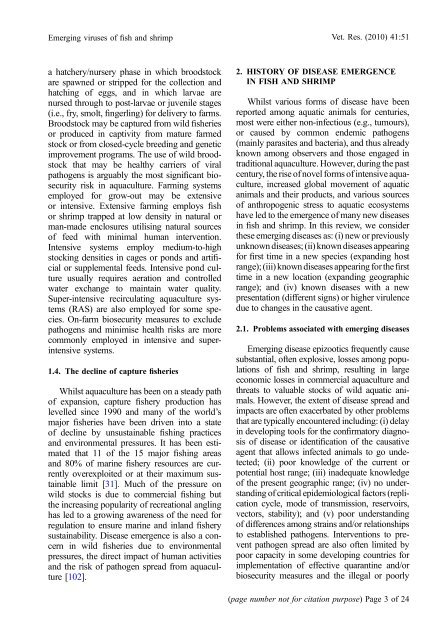Emerging viral diseases of fish and shrimp - Watershed Watch ...
Emerging viral diseases of fish and shrimp - Watershed Watch ...
Emerging viral diseases of fish and shrimp - Watershed Watch ...
Create successful ePaper yourself
Turn your PDF publications into a flip-book with our unique Google optimized e-Paper software.
<strong>Emerging</strong> viruses <strong>of</strong> <strong>fish</strong> <strong>and</strong> <strong>shrimp</strong> Vet. Res. (2010) 41:51<br />
a hatchery/nursery phase in which broodstock<br />
are spawned or stripped for the collection <strong>and</strong><br />
hatching <strong>of</strong> eggs, <strong>and</strong> in which larvae are<br />
nursed through to post-larvae or juvenile stages<br />
(i.e., fry, smolt, fingerling) for delivery to farms.<br />
Broodstock may be captured from wild <strong>fish</strong>eries<br />
or produced in captivity from mature farmed<br />
stock or from closed-cycle breeding <strong>and</strong> genetic<br />
improvement programs. The use <strong>of</strong> wild broodstock<br />
that may be healthy carriers <strong>of</strong> <strong>viral</strong><br />
pathogens is arguably the most significant biosecurity<br />
risk in aquaculture. Farming systems<br />
employed for grow-out may be extensive<br />
or intensive. Extensive farming employs <strong>fish</strong><br />
or <strong>shrimp</strong> trapped at low density in natural or<br />
man-made enclosures utilising natural sources<br />
<strong>of</strong> feed with minimal human intervention.<br />
Intensive systems employ medium-to-high<br />
stocking densities in cages or ponds <strong>and</strong> artificial<br />
or supplemental feeds. Intensive pond culture<br />
usually requires aeration <strong>and</strong> controlled<br />
water exchange to maintain water quality.<br />
Super-intensive recirculating aquaculture systems<br />
(RAS) are also employed for some species.<br />
On-farm biosecurity measures to exclude<br />
pathogens <strong>and</strong> minimise health risks are more<br />
commonly employed in intensive <strong>and</strong> superintensive<br />
systems.<br />
1.4. The decline <strong>of</strong> capture <strong>fish</strong>eries<br />
Whilst aquaculture has been on a steady path<br />
<strong>of</strong> expansion, capture <strong>fish</strong>ery production has<br />
levelled since 1990 <strong>and</strong> many <strong>of</strong> the world’s<br />
major <strong>fish</strong>eries have been driven into a state<br />
<strong>of</strong> decline by unsustainable <strong>fish</strong>ing practices<br />
<strong>and</strong> environmental pressures. It has been estimated<br />
that 11 <strong>of</strong> the 15 major <strong>fish</strong>ing areas<br />
<strong>and</strong> 80% <strong>of</strong> marine <strong>fish</strong>ery resources are currently<br />
overexploited or at their maximum sustainable<br />
limit [31]. Much <strong>of</strong> the pressure on<br />
wild stocks is due to commercial <strong>fish</strong>ing but<br />
the increasing popularity <strong>of</strong> recreational angling<br />
has led to a growing awareness <strong>of</strong> the need for<br />
regulation to ensure marine <strong>and</strong> inl<strong>and</strong> <strong>fish</strong>ery<br />
sustainability. Disease emergence is also a concern<br />
in wild <strong>fish</strong>eries due to environmental<br />
pressures, the direct impact <strong>of</strong> human activities<br />
<strong>and</strong> the risk <strong>of</strong> pathogen spread from aquaculture<br />
[102].<br />
2. HISTORY OF DISEASE EMERGENCE<br />
IN FISH AND SHRIMP<br />
Whilst various forms <strong>of</strong> disease have been<br />
reported among aquatic animals for centuries,<br />
most were either non-infectious (e.g., tumours),<br />
or caused by common endemic pathogens<br />
(mainly parasites <strong>and</strong> bacteria), <strong>and</strong> thus already<br />
known among observers <strong>and</strong> those engaged in<br />
traditional aquaculture. However, during the past<br />
century, the rise <strong>of</strong> novel forms <strong>of</strong> intensive aquaculture,<br />
increased global movement <strong>of</strong> aquatic<br />
animals <strong>and</strong> their products, <strong>and</strong> various sources<br />
<strong>of</strong> anthropogenic stress to aquatic ecosystems<br />
have led to the emergence <strong>of</strong> many new <strong>diseases</strong><br />
in <strong>fish</strong> <strong>and</strong> <strong>shrimp</strong>. In this review, we consider<br />
these emerging <strong>diseases</strong> as: (i) new or previously<br />
unknown <strong>diseases</strong>; (ii) known <strong>diseases</strong> appearing<br />
for first time in a new species (exp<strong>and</strong>ing host<br />
range); (iii) known <strong>diseases</strong> appearing for the first<br />
time in a new location (exp<strong>and</strong>ing geographic<br />
range); <strong>and</strong> (iv) known <strong>diseases</strong> with a new<br />
presentation (different signs) or higher virulence<br />
due to changes in the causative agent.<br />
2.1. Problems associated with emerging <strong>diseases</strong><br />
<strong>Emerging</strong> disease epizootics frequently cause<br />
substantial, <strong>of</strong>ten explosive, losses among populations<br />
<strong>of</strong> <strong>fish</strong> <strong>and</strong> <strong>shrimp</strong>, resulting in large<br />
economic losses in commercial aquaculture <strong>and</strong><br />
threats to valuable stocks <strong>of</strong> wild aquatic animals.<br />
However, the extent <strong>of</strong> disease spread <strong>and</strong><br />
impacts are <strong>of</strong>ten exacerbated by other problems<br />
that are typically encountered including: (i) delay<br />
in developing tools for the confirmatory diagnosis<br />
<strong>of</strong> disease or identification <strong>of</strong> the causative<br />
agent that allows infected animals to go undetected;<br />
(ii) poor knowledge <strong>of</strong> the current or<br />
potential host range; (iii) inadequate knowledge<br />
<strong>of</strong> the present geographic range; (iv) no underst<strong>and</strong>ing<br />
<strong>of</strong> critical epidemiological factors (replication<br />
cycle, mode <strong>of</strong> transmission, reservoirs,<br />
vectors, stability); <strong>and</strong> (v) poor underst<strong>and</strong>ing<br />
<strong>of</strong> differences among strains <strong>and</strong>/or relationships<br />
to established pathogens. Interventions to prevent<br />
pathogen spread are also <strong>of</strong>ten limited by<br />
poor capacity in some developing countries for<br />
implementation <strong>of</strong> effective quarantine <strong>and</strong>/or<br />
biosecurity measures <strong>and</strong> the illegal or poorly<br />
(page number not for citation purpose) Page 3 <strong>of</strong> 24
















